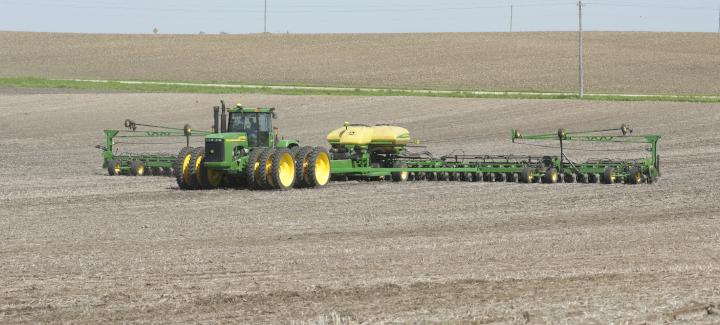
A number of factors can lead to sidewall compaction. The first is planting too early into soil that’s too wet. Other factors include planting at too shallow a depth and placing too much downward pressure on the press and closing wheels. These three factors can be avoided this spring if you have patience with your soil and do your due diligence to ensure your planter is in proper working condition for ideal seed-to-soil contact. Skipping these steps could cause irreversible damage to your crop and put your fields at risk of ponding and nutrient runoff. Here are a few tips to help avoid sidewall compaction this planting season.
Avoid Planting into Cool, Wet Soil
Don’t cave to the temptation of getting your crops in early without doing your research first. Wet soil is a major contributor to sidewall compaction, and your soil may not be dry enough to get the seed placement you need. Wet weather and the lack of a hard winter freeze are two reasons your soil may be holding extra moisture. Most growers rely on a hard winter freeze to help draw excess moisture from the soil. If a hard freeze did not take place, and if you’ve experienced heavy rains this spring, it’s vital to check your soil moisture before you hit the field.
You want to make sure your soil temperature is consistently above 52 degrees Fahrenheit for corn and 50 degrees Fahrenheit for soybeans. Planting into cool, wet soils can affect the germination process for both crops, leading to problems such as chilling injury, uneven emergence, poor stands and, ultimately, yield loss.
Experts at Penn State Extension note there are two ways to test your soil moisture, both of which involve rolling a chunk of soil into a ball. You want to check your soil at the level you anticipate planting, so anywhere between two to three inches. The first test is to throw the ball of soil into the air. If the ball stays intact when it reaches the ground, it’s probably too wet to start planting. The second method is to collect a sample at the same depth, roll it into the ball and pinch it between your thumb and forefinger. Experts say that if it breaks before reaching roughly a three-inch-long ribbon, it’s probably too wet.
Avoid Planting Too Shallow
Seed placement is key to ensuring the necessary root growth that will provide your crop with early-season vigor, even emergence and standability. If you plant too shallow, the seed itself may not become compacted but rather the root growth might. If you plant at a depth that’s less than what your press wheels are designed to reach (often 2- to 3-inches deep), the soil packs below the furrow and the seed, which results in roots that cannot penetrate the soil and end up growing sideways versus straight down. When you plant too shallow, you also increase your risk of the seed furrow opening back up after a dry period, potentially exposing the seed.
We typically recommend corn planting depths around 2 to 3 inches and soybean planting depths around 1.5 to 2 inches. Always make sure the pressing and closing wheels are set appropriately for these planting depths. We discuss this in more detail below.
Don’t Apply Too Much Downward Pressure
According to experts at the University of Nebraska Lincoln, most sidewall compaction occurs when press wheels are set with too much pressure. The reason? As noted previously, when the pressing wheels are set below the planting depth, you risk compaction below the seed, resulting in improper root penetration. It’s recommended to check the down pressure of the press wheels at the seeding depth versus the top of the seed vee. You can always adjust the down pressure setting on your tires as needed. At the end of the day, you need to ensure that your seed is at the proper planting depth, your press wheels are adjusted at the depth you plan to place the seed and your closing wheels are at the right depth to ensure your seed vee is properly closed.
For more information on the impact of soil compaction on your crops, contact your local Stine sales rep.
Related Articles
-

Stine® to offer Syngenta’s Victrato® soybean seed treatment in 2026
December 2025 in Agronomy
-

Use Stine’s XP® seed treatments to prevent early injury to your crops
December 2025 in Agronomy
-

Understanding Stine’s enhanced oil profile soybeans
December 2025 in Agronomy
-

Soil sampling sets the stage for spring
November 2025 in Agronomy



